Paired practice questions for Illustrative Mathematics
The Illustrative Mathematics (IM) curriculum is widely praised, and for good reason—the questions are outstanding! They’re well-written, interesting, varied, and graphically rich, as you can see in the samples below.
Occasionally we hear from teachers who use the IM curriculum that there’s a need for more practice questions, or questions which are kept in reserve for tests, quizzes, and review. So we took it upon ourselves to write those questions—4700 of them!—and they’re now available in Problem-Attic.
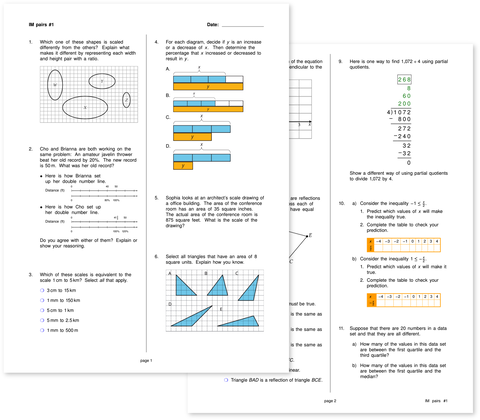
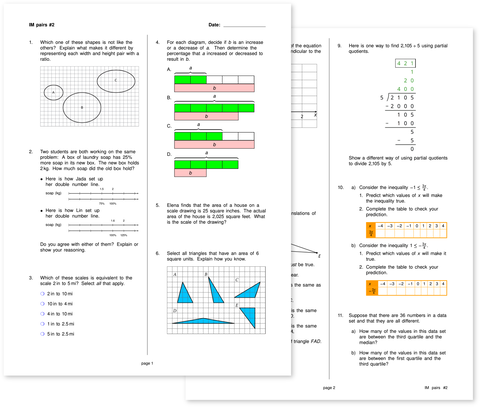
Matching documents made with IM Paired Practice bank.
We’re calling the questions “paired practice”, but of course they can be used for assessment, too. This page tells how the questions are organized, and it has some suggestions for making the best use of them.
Here are a few things to know about the Illustrative Mathematics questions:
-
To access the paired questions (those written by EducAide), a school subscription is required. But the original questions from Illustrative Mathematics are freely available in Problem-Attic.
-
For Texas teachers, in particular: the IM curriculum is based on Common Core, but we’ve re-aligned nearly 6000 questions to the TEKS. You can add these to Problem-Attic through an installable framework. There’s a framework for free accounts and a second framework for teachers at subscribing schools. The latter has the paired questions. You’ll find more information here.
-
If you have access to the paired questions, please distribute them to your students only, and try to keep them off public websites. It’s in everyone’s interest if the paired questions remain “semi-secure”. Then the questions will be new to students and it won’t be so easy to search online for answers.
How to access Illustrative Mathematics questions
In Problem-Attic, there are two different banks with IM questions. If you have added them to My Banks, then you will see them mixed in with other titles, something like this:
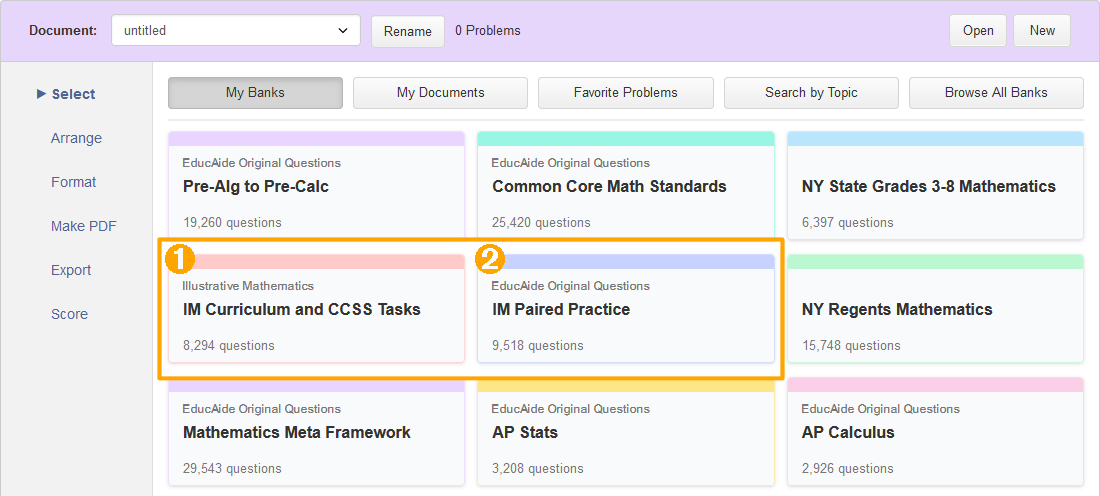
If you don’t see the titles, you can access them by clicking the Browse All Banks button.
The first bank, called “IM Curriculum and CCSS Tasks”, has questions that were originally written by Illustrative Mathematics, about 8300 of them. They’re available to everyone. If you go into the bank, you’ll see the questions organized by level (elementary, middle and high) and by Common Core tasks, Units/Lessons, and Practice. You can drill down, select whatever questions you like, and mix and match with other questions from the Problem-Attic database.
The second bank, called “IM Paired Practice” has the matching questions written by EducAide. Use of this bank requires a school subscription. The questions are organized by units and lessons, similar to the first bank. They are for middle and high school grades. (As of this writing, IM elementary questions are not yet paired.)
How to take advantage of the pairing
The best way to understand the pairing is to think of traditional math textbooks. The homework exercises were typically done as odd/even pairs at the end of each section. If you go into the IM Paired Practice bank and scroll through a unit and lesson, you’ll see the same thing. Two questions in a row are always similar. Here is an example:
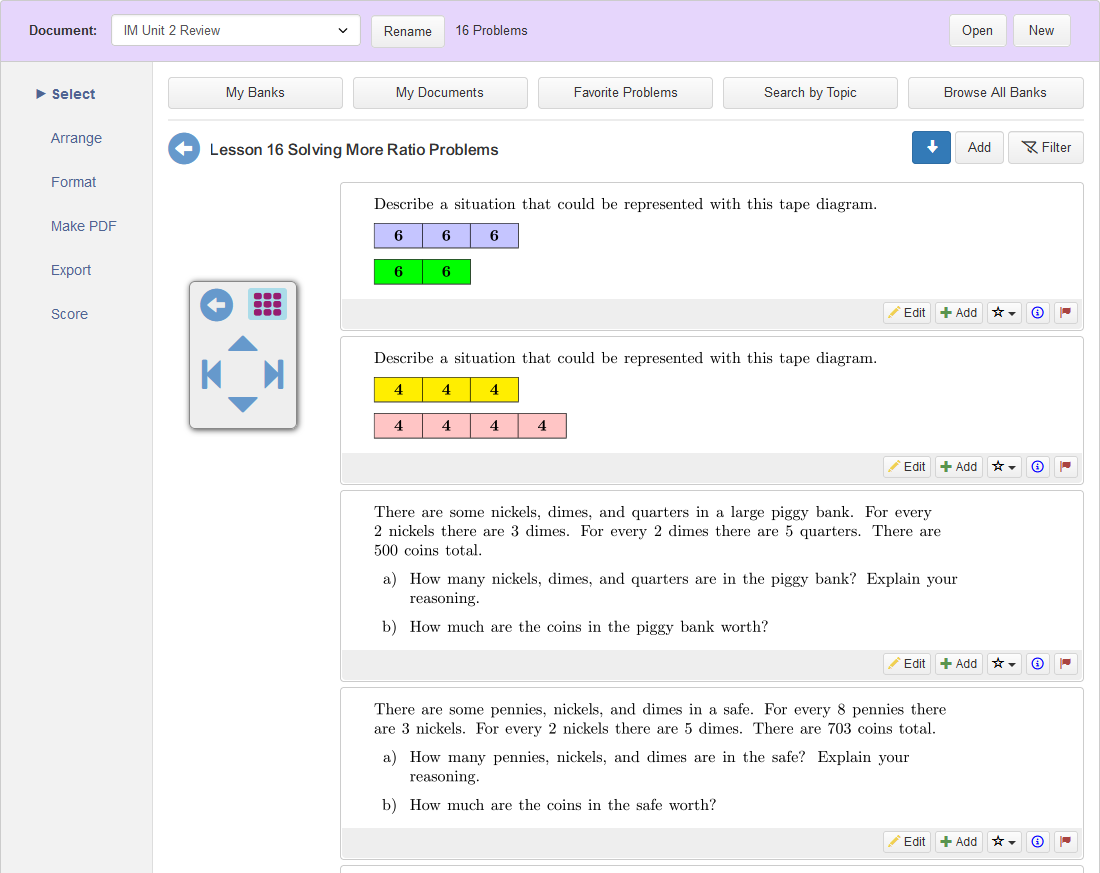
Of the two paired questions, the first is the original from Illustrative Mathematics. The second is the newly-written, matching question from EducAide. By convention, we’ll refer to first question as “odd” and the second as “even”. Just to be clear, the odd questions are copied from the other Illustrative Mathematics Bank. This is for your convenience, so you have them right next to EducAide's questions.
Of course, there are many things you can do with paired questions. You can keep one set (odd or evens) in reserve for tests and quizzes, or you can use the matched questions for review worksheets, test forms A and B, make-up tests, etc. The rest of this page introduces some Problem-Attic features, often overlooked, which make problem selection very fast and which help you take advantage of the pairing.
Selecting questions at random
One of the best shortcuts in Problem-Attic is right-clicking on a category of questions. This is a fast way to cover a particular topic or lesson, or to get a wide range of questions across many topics at once. You can also think of this option as a way to “over-select”, or to get more questions than you actually want to use. After selecting, you can narrow them down on the Arrange tab.
To use this option, click on the IM Paired Practice bank. Then, when you see the main topics or categories, click the Expand All button. Right-click on a category (at any level) and you’ll see a flyout that says, “Add Problems”. Click the option, then specify the number that you want.
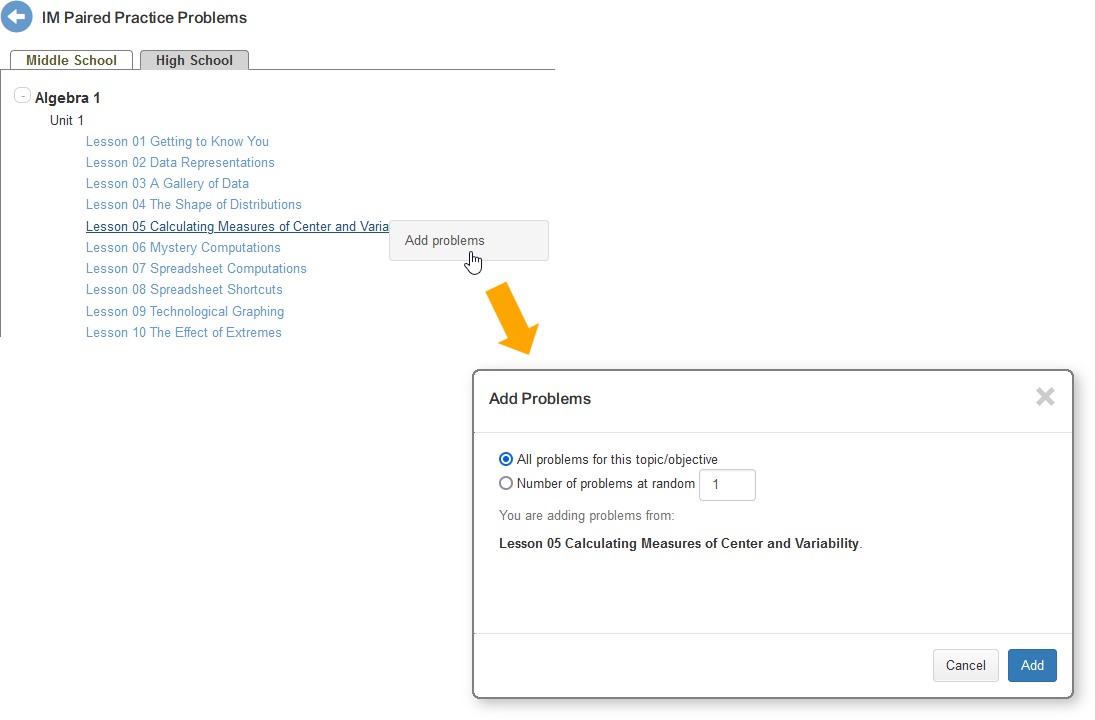
After adding problems with the right-click option, you can repeat the process for other categories. The most important thing to remember: the higher up you click, the more widely distributed the questions will be. It’s even possible to right-click on a tab near the top of the page and select questions for an entire grade or course.
We’ll use the right-click option in the next section when showing how to create test forms A and B. For additional details, or to learn about one more shortcut (the Navigation panel), see this help page.
Parallel forms
As mentioned above, for IM Paired Practice questions, two in a row will be similar. This odd/even pairing has many uses. Here we’ll show how to create test forms A and B by introducing a related option in Problem-Attic: Parallel Forms. This is meant to be a hands-on, so you can see how easily the forms are created.
Follow these steps:
- In Problem-Attic, click the New button at the top right. Call your document “Test Form A”.
- Click the Select tab. Click My Banks or Browse All Banks and look for IM Paired Practice.
- Click to open the bank, and click the Middle or High School tab. You can expand the table of contents if you like. Then, click on a grade or course with your right mouse button.
- Click the flyout message, “Add Problems”. In the dialog that comes up, type 20 for “Number of Problems at Random”. Then press the Add button.
- Click the Make PDF tab on the left. When your document is shown, click Download. Open it in a new browser tab or in a PDF reader.
- In Problem-Attic, click the New button again. This time, call your document “Test Form B”, and click the “Copy of” radio button. (Problem-Attic should show Test Form A as the default for copying.)
- You’ll now see Options for Parallel Forms. Select the option, “Switch problems (make use of odd/even pairs)”, then click Create.
- Click Make PDF. Download your new document and open it.
Now you can compare the two documents you just made. Depending on the questions, it’s possible page breaks will be a little different. Otherwise, the documents should be very close in appearance, level of difficulty, and coverage.
The parallel forms option works with the entire database in Problem-Attic, not just the IM Paired Practice questions. However, it’s designed for those parts of the database where questions are intentionally paired. This is true for nearly all questions written by EducAide: Common Core Math, AP Calculus and AP Stats, Pre-Alg to Pre-Calc, etc.
Filter
There is one more option in Problem-Attic which will help you take advantage of odd/even pairs. It’s the Filter button. You will see it when you drill down into the database and are looking at problem “thumbnails”.
When you click the Filter button, you see a dialog box with options.
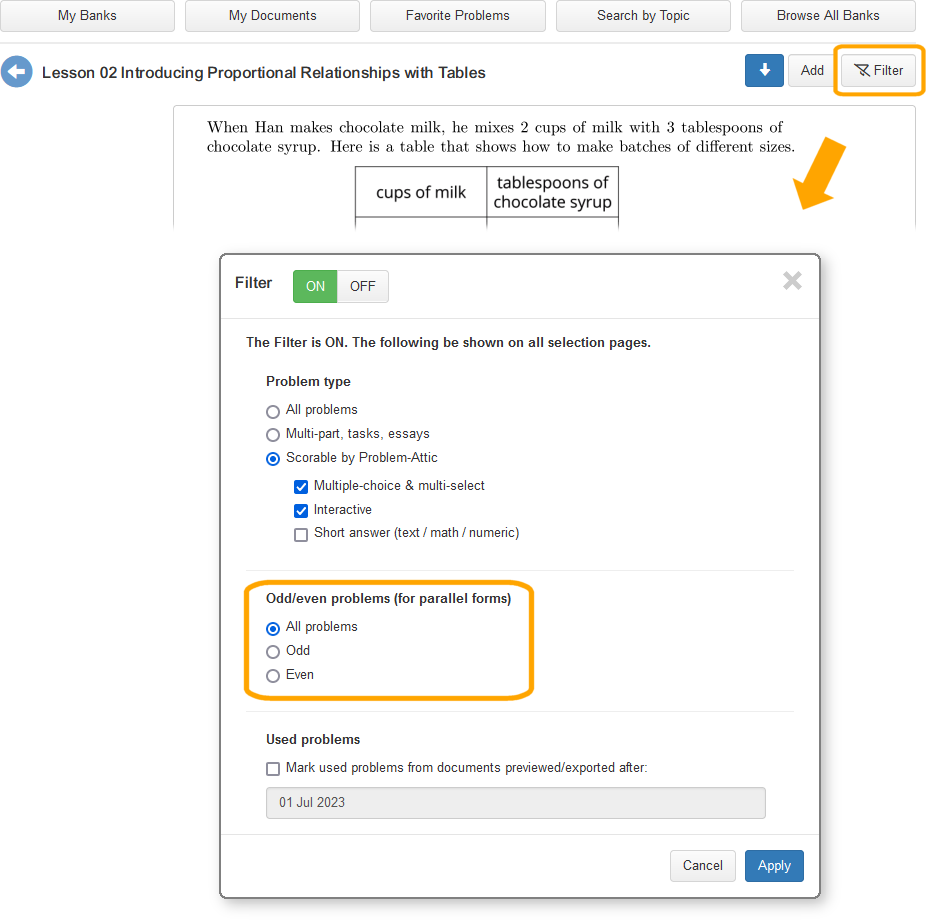
The options we've highlighted are most relevant to paired questions. The idea, when you’re selecting questions, is to show only the odds or evens, so the others are kept in reserve.
For example, let’s assume during the semester you want to select questions for homework, review and quizzes. You might show only the odd questions when you’re creating those documents. Then, when it comes time to make chapter tests or a final exam, you can do the reverse: show the even questions. This will assure that you’re looking only at questions which haven’t already been used.
For the IM Paired Practice questions, keep in mind that the odd questions are those originally written by Illustrative Mathematics. Many or most are posted on the internet with answers, so there’s no particular reason to keep them in reserve. Instead, you’ll probably want to hold off using the even questions, which were written by EducAide, until you need them for testing.
As noted above, it’s beneficial to you and other teachers if you keep the even-numbered questions “semi-secure”. Definitely don’t post them on a public-facing website. They are not licensed the same as the questions written by Illustrative Mathematics, and we appreciate your following the Problem-Attic Terms of Service when making use of them.
We hope you like the IM questions and, if you haven’t adopted that particular curriculum, they are still useful for assessment and for supplementing lessons. We welcome your comments and suggestions for improving the database.